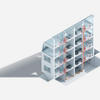Drinking water installations

Hygiene problems
Over the last few years, it has become obvious that serious microbiological problems can be lurking in drinking water installations. New research shows that bacteria in drinking water are responsible for far more infections than was previously thought.
Trade professionals believe the weak points are primarily:
Incorrect and unprofessional installation of the piping system
A lack of hygiene during installation or commissioning
Operating errors after commissioning
The following measures are especially important during the planning and installation of drinking water systems:
Do not create a breeding ground for bacteria by selecting suitable materials
Reduce stagnation times by choosing pipe dimensions compliant with use and taking into account actual pressure losses and the user’s behaviour
Insulate properly to prevent an impact on the drinking water quality caused by heating or cooling
To breed in drinking water, microorganisms require certain temperatures. For this reason, the temperature of the cold water should not exceed 25°C and the temperature of the hot water should not fall below 55°C. The presence of the following bacteria, among others, in drinking water systems is an indicator of water quality:
Pseudomonas Aeruginosa
This bacterium is one of the most important pathogens passed on by drinking water – especially through infections contracted in hospitals. Its optimal breeding temperature range is between 25 – 30°C. No pathogen should be present in a water sample of 100 ml, as, according to the Robert Koch Institute (RKI), even the lowest of concentrations is considered harmful to health. Treatment of the triggered infections is difficult. In humans, they can lead to severe inflammatory organ diseases, even resulting in death. The presence of pathogens in drinking water installations causes buildings to be immediately closed and subsequent renovation work to be carried out.
Legionella Pneumophila
Legionella breed most effectively between 25 – 45°C. In 1976, the first known Legionella epidemic caused 30 deaths in a hotel in the USA. Since then, the press has often on reported similar cases. In Germany, there are approx. 30,000 cases of Legionella illnesses each year. With a fatality rate of 10 to 15 %, this means approximately 3,000 deaths per year. The infection rate is much lower in other countries: 34.1 (Spain), 19.2 (Denmark), 17.9 (The Netherlands) and 16.9 (France) per million inhabitants.
National and EU Regulations
To avoid problems, every country has regulations for the safe supply of water. New regulations, which compliment or replace national regulations, are constantly being introduced by the EU. EN 806 and EN 1717 are important European standards for the preservation of drinking water quality. This makes it necessary to consult the regulations for such technology on a regular basis and to use them in practice at short notice. For example, in Germany the dry leakage test has become standard in large installations such as hospitals or hotels due to reasons of hygiene. Even the flushing of the installation takes place as late as possible. In some countries, inadequate drinking water quality is a criminal offence.
Summary
The highest possible drinking water quality is only possible as a result of cooperative responsible action from planners, installers and operators.

Image: Pseudomonas aeruginosa is one of the most significant pathogens of infection that can be spread through drinking water in buildings.
Planning
When dealing with drinking water, only technically and hygienically optimised solutions, from the planning stage right through to operation, can guarantee the required water quality.
From an economic and hygienic point of view, “streamlined” installations are the optimal aim of the planning procedure. For this reason, 1) every seldom used extraction point should be looped into the system and 2) the main extraction point or flushing system should be placed at the end of the branch line.
A prerequisite for regular and complete water exchange – already in operation carried out as intended – is the intelligent structuring of consumers along the storey.
A T-piece installation can be used in buildings or areas without increased hygiene requirements for frequently used extraction points with short connection pipes.
Serial pipe systems are the system of choice, so that pipes with seldom used extraction points, such as frost-proof external fittings are not a danger for the rest of the installation. By doing this, the extraction points are connected using wall plates with two outlets and with a regularly-used end extraction point, e.g. a WC system (possibly combined with a flushing system).
A ring pipe system is useful if, due to increased hygiene requirements, a serial pipe system is out of the question, e.g. because there is no main extraction point. In this way, multiple users can be looped in – even those in other rooms. If water is used in one of the rooms, water flows from both sides and flushes through the unused extraction point.
Choice of Materials
Unsuitable materials can cause the transfer of unwanted nutrients into the drinking water of a domestic installation. EN 12502 describes the influence of material parameters on drinking water quality. All materials used by Viega fulfil these requirements.
Plan the Optimal Dimensions
In the field of drinking water installations, the use of smaller piping systems in combination with flow-enhancing components is extremely advantageous both in terms of hygiene and cost-effectiveness. On the one hand, you can prevent an increased use of material and on the other; you reduce the amount of water in the pipes.
To prevent over-dimensioning, the exact calculation of the actual amount of water extracted and the synchronisms of the particular building are necessary. Using the values which can vary within a certain bandwidth, e.g. the flow rate in respect to real pressure losses, the dimensions in the network pipe can be considerably reduced. By using low pressure loss shut-off valves, e.g. ball valves, extra pressure potential can be used.
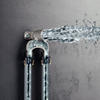
Image: Pressure loss-optimised piping systems and connectors with flow-enhancing geometry help provide noticeably improved flow performance and hygiene.
Installation and Commissioning
Drinking water hygiene starts long before the vital provision flows out of the tap. Even during manufacture, transportation, storage and assembly, contamination of the parts that come into contact with water must be avoided.
The same care must be taken during the leakage test, flushing and initial filling of the system as during planning and installation.
Transportation, Storage and Assembly
All components of a drinking water system must be transported and stored in such a way that internal contamination is avoided. To ensure the perfect condition of the system components, the protective devices must not be removed until directly before assembly. Viega produces protective caps, which make it possible to close steel or copper pipe ends during the installation phase. In addition, Viega connectors and other components are all placed in protective packaging. In this way, all components are protected against contamination and damage throughout transportation right up until assembly.
Dry leakage test
For reasons of hygiene, it is recommended that leakage tests are carried out dry in large buildings. Dry, oil-free air is used or in systems with higher hygienic requirements (e.g. hospitals) inert gases may be used. The relevant safety regulations should be observed. Dry leak testing is carried out before load testing at a test pressure of 110 mbar. The test period lasts at least 30 minutes at up to 100 litres of piping system capacity and has to be increased by 10 minutes for every additional 100 litres. During this test non-pressed press connectors can be identified. The Viega SC-Contur, which can be found on every Viega press connector, guarantees the identification of non-pressed connections throughout the entire pressure range from 22 mbar to 3 bar.
Wet leakage test
Wet leak testing is only carried out on systems which will go into operation shortly afterwards (e.g. detatched houses). The system should be filled with filtered drinking water. Viega press connectors which have not been pressed will be visibly leaky up to a maximum pressure of 6.5 bar. If the pressure test is carried out during frosty periods, a dry test is recommended in smaller installations as well.

Image: Protective caps on stainless steel or cooper pipe ends protect against contamination and damage during transportation and storage.
Operations
At the handover of a system, the operator should be made aware that, from that point onwards, (s)he is responsible for regular and complete exchange of drinking water and for operation of the system as it is intended, at all extraction points. In some countries, disregarding the relevant ordinances constitutes a criminal offence.
For buildings, whose usage requires increased hygiene measures (e.g. food processing premises, hospitals, care homes), a hygiene plan is agreed by the operator, a hygienist, the relevant health authorities and, if applicable, the water supplier. The hygiene plan of the drinking water installation must be compiled for the specific use and system and must contain details of the intended use of the drinking water installation. It is recommended that a maintenance contract for the drinking water installation is concluded with a specialist company or that the measures are carried out by one’s own specially trained specialists.
Drinking Water safely under control with Viega System Solutions
Water quality controls for public buildings are mandatory. Therefore, water must be regularly chemically and microbiologically tested at extraction points in public buildings. So that these samples can be extracted under laboratory conditions, without contamination of the parameter via external influences, Viega has developed the two-part and, subsequently, cost-effective Easytop sample extraction valve. It consists of a permanently secured zero stagnation space extraction valve and an, especially for the extraction process attached, actuator which can be sterilised. All of the parts which come into contact with water are made of gunmetal and can therefore be treated in autoclave temperatures or flame treated.
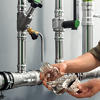
Image: Easytop sample extraction valve for the professional sampling of drinking water.
System solutions

Viega system solutions offer a maximum level of flexibility and make it possible for you to operate a fast, safe and completely hygienic drinking water installation.
You can find more detailed information about the various system solutions on the following pages.
Our Contribution to Drinking Water Hygiene
Viega system solutions fulfil all technical requirements for professional solutions and materials for drinking water installation, consequently offering a maximum of security.
Materials, production and quality control
Viega only uses materials suitable for use with drinking water such as stainless steel, copper and copper alloys. All organic materials for seals and pipes regularly undergo the relevant chemical and microbiological tests.
The surfaces of products, that will come into contact with water later on, are not moistened with water during their quality control tests. This is the only way to prevent microbiological contamination caused by the production process.
Innovative Product Design
Viega press connectors made of copper, gunmetal and stainless steel cause much less flow resistance than other types of plastic or press brass connectors that are available on the market. When using plastic connectors, a solid core is required for all subsequent cavities, which is then extracted again after production. Brass connectors are simply bored at a right angle – quite the opposite of the flow-enhancing water flow conditions from Viega.
Planning, Installation, Commissioning
In our practical seminars, you will find out all there is to known about the latest standards and regulations, the right material selection, pipework, commissioning and operation of drinking water installations. Please contact your local Viega office for more information on seminars.
In the download area, you will find more information, for example, the practical manual, protocols and trade articles, on the subject of drinking water installations and hygiene.
Viega planners and consultants are always available to provide you with professional information and personal support during your planning procedure.
Dry leakage test thanks to Viega Smart Connect Feature
For reasons of hygiene, it is recommended that leakage tests are carried out dry in large buildings. Dry, oil-free air is used or in systems with higher hygienic requirements (e.g. hospitals) inert gases may be used. The relevant safety regulations should be observed. Dry leak testing is carried out before load testing at a test pressure of 110 mbar. The test period lasts at least 30 minutes at up to 100 litres of piping system capacity and has to be increased by 10 minutes for every additional 100 litres. During this test non-pressed press connectors can be identified. The Viega Smart Connect Feature, which can be found on every Viega press connector, guarantees the identification of non-pressed connections throughout the entire pressure range from 22 mbar to 3 bar.
Examples of use
In buildings, interruptions in the use of the system cannot be avoided. Unused areas should either be shut off or regularly flushed to prevent negative effects on other parts of the installation. On the basis of the type and intensity of use, various types can be defined:
Type 0: Use rarely interrupted
Type 0 indicates all buildings in which there is rarely an interruption in use, for example residential apartment buildings.
Of course, short periods of stagnation also occur here in the drinking water system, caused by short periods of non-occupation such as the absence of the user (holidays) or when tenants are changing. However, these can safely and easily be remedied by a short flushing of the system by the user on his/her return. In Type 0 buildings, there are no increased requirements regarding hygienic conditions.
- When properly planned, designed and operated, Type 0 buildings require no automatic flushing, although it may be advantageous in larger properties with guest rooms.
- In the upkeep or renovation of Type 0 buildings, an evaluation of the existing conditions is necessary (temperature, determination of the amount and frequency of water extraction at the individual points, determination of the water quality through sampling). The extent of the renovation can be based on the information gathered.
With Type 0 buildings, professional planning, design and operation is normally adequate: by observing the actual pressure looses of, for example, connectors, valves and small simultaneous factors, pipe length and volumes can be minimized. Seldom used, but desired extraction points are looped-in.
| Viega Hygiene+ System Solution for Type 0 Buildings |
| Looping-in of the extraction points with dual-wall plates and wall plate T-piece |
| The assembly unit for membrane expansion tanks also allows for circulating water and, with it, reliability in drinking water supply. |
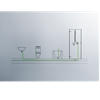
Type 1: Interruption in use on a room/ apartment basis
Type 1 buildings place higher hygiene demands on the drinking water installation. Due to possibly longer unoccupied periods in individual rooms or residential units, incidents of stagnation often occur in the piping system.
This can have a negative effect on other rooms or residential units which are in use such as in hotels, hospitals and retirement homes. Especially in public buildings and facilities, the maintenance of the water quality is paramount. It is the express responsibility of the planner, installer and operator to fulfil this duty.
In hotels, for example, a Viega cistern can be installed locally in each room, equipped with a Visign for Care actuating panel with Viega Hygiene+ flushing function. In this way, the rooms are equipped with an intelligent electronic flushing device which is regulated as per demand and volume, which ensures periodical flushing when the room is not used. As soon as a room is used and water is extracted from the system again as a result, the system registers this and the automatic flushing stops.
With Type 1 buildings, flushing measures that are coordinated as per demand and volume are wise as these work in an automated way which conserves resources:
- When used regularly, no mandatory flush occurs.
- The flush programmes recognise interruptions in use and flush the pre-set volume of water in the pre-stored in the pipes on the storey.
- The water quality is maintained, drinking and waste water costs are kept to a minimum.
| Viega Hygiene+ System Solution for Type 1 Buildings |
| Looping-in of the extraction points with dual-wall plates and wall plate t-piece |
| Equipment of each room with an actuating panel with Hygiene+ flushing function |
| The intelligent Viega Hygiene+ flushing system flushes automatically after an individually settable time period, for example, a water volume of 3 litres 3 x a week. |
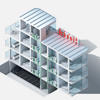
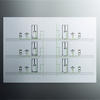
Type 2: Interruption in use on a storey basis
Type 2 buildings have usage periods that are hard to calculate due to different characteristics and differing living and working habits of the individual parties concerned.
A supermarket on the ground floor is not used on Sundays and the doctor’s surgery on the first floor has regular company holidays. This has a negative effect on the other areas that continue to be used.
Automated flushing at the end of each storey‘s pipe system, which is advisable from a planning perspective, ensures the best water quality for all users at any time of the day or year.
With Type 2 buildings, flushing measures that are coordinated as per demand and volume are wise as these work in an automated way which conserves resources:
- When used regularly, no mandatory flush occurs.
- The flush programmes recognise interruptions in use and flush the pre-set volume of water in the pre-stored in the pipes on the storey.
- The water quality is maintained, drinking and waste water costs are kept to a minimum.
| Viega Hygiene+ System Solution for Type 2 Buildings |
| Looping the sample extraction valve with dual-wall plates and wall-plate T-piece |
| Storey pipe systems with actuating panel with Viega Hygiene+ flushing function |
| The intelligent Viega Hygiene+ flushing system flushes automatically after an individually settable time period, for example, a water volume of 4 litres 3 x a week. |
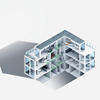
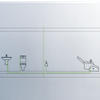
Type 3: Interruption in use on a building basis
Type 3 buildings are identifiable as being buildings that have vacant periods that can last many weeks at a time. This is the case with, for example, schools and nurseries, due to long weekends and holidays.
Seasonal hotels, trade fair halls, barracks and event rooms have vacant periods of many days, weeks or even months. But at the same time, the water quality of such buildings is under close scrutiny due to use by the public.
To ensure the prevention of stagnation, automatic flushing with flush module at the end of each storey pipe system is advisable. In this case, a pre-set flushing volume, which corresponds to the stagnating water volume, should be flushed through the system. However, a 24-hour urinal flushing system can also be of benefit in Type 3 buildings.
With Type 3 buildings, flushing measures that are coordinated as per demand and volume are wise as these work in an automated way which conserves resources:
- When used regularly, no mandatory flush occurs.
- The flush programmes recognise interruptions in use and flush the pre-set volume of water in the pre-stored in the pipes on the storey.
- The water quality is maintained, drinking and waste water costs are kept to a minimum.
| Viega Hygiene+ System Solution for Type 3 Buildings |
| Looping-in of the extraction points with dual-wall plates and wall plate T-piece |
| Storey pipe systems with actuating panel with Viega Hygiene+ flushing function and/or Visign urinal flushing system with 24-hour flush interval |

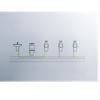
Hot water installation
The hot water quality can be adversely affected, even when the cold water is microbiologically pure. For example, Legionella can bread if temperatures of less than 55 °C occur in the hot water.
To ensure drinking water quality in hot water, the following measures should be taken:
Circulation Systems when the Pipe Volume exceeds 3 Litres
When the pipe volume exceeds a volume of 3 litres between the outlet of the hot water tank and the outermost extraction point, circulation systems should be installed – either as a parallel system or an internal circulation pipe. These should be calculated in such a way that the water temperature in the circulating system does not drop more than 5 K below the tank exit temperature (60°C/ 55 °C).
Circulation systems should be balanced with regulating valves either completely or in parts of the system. The following is required for the design of such a system:
- Determination of the required circulation volume flows through the heat loss of the pipes
- Determination of a temperature difference of max. Δt 5 K
- Specification of an available pipe friction pressure gradient
- Hydraulic balancing of favourable circulation circuits through the pipe diameter, taking s maximum permitted flow rate into account
Up to a Pipe Volume of 3 Litres
With a water volume of up to 3 litres, a circulation pipe is not necessary. The volume of 3 litres per pipe section without circulation should be regarded as a maximum volume. For reasons of hygiene, the water volume should be kept as low as possible.
Insulation
In all types of buildings, the hot water pipes should be insulated with an insulating layer that fulfils the minimum requirements of EnEV (in Germany). National regulations should be observed.
Flushing Systems in the Hot water Supply
A flushing system is neither economically nor hygienically recommended for hot water provision because
- Pure hygienic conditions are present in the circulation.
- In the cooled hot water of the branch line, there is no excessive bacterial breeding.
- The user does not use cooled hot water.
- The branch line is thermally disinfected during use.
